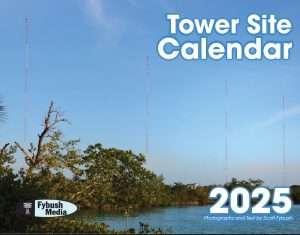Site of the Week 2/4/2022: WNIS 790, Norfolk VA
Text and photos by SCOTT FYBUSH
When we last visited Virginia’s Hampton Roads region a few years back, we spent most of our time in its central city, Norfolk, with some side trips to sites to the south across the Elizabeth River in Portsmouth, Chesapeake and Suffolk.
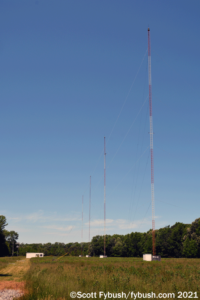
That left us with some big parts of the area unexplored, most notably the “Peninsula” cities across the James River, Hampton and Newport News – and so when we were back in the area in May 2021, we were happy to have some good reasons to go across the river to see what was on the other side.
On the way from our last stop last week, the WTAR 850 site, to the James River Bridge, which brings US 17 across to Newport News, we passed another directional AM site: WKQA (1110 Norfolk), with four towers just east of the US 258/US 17 junction south of the bridge. This 50,000-watt daytimer was a late addition to the dial here, signing on in 1976 as WZAM, and it may be an early exit, too – the land here, not far from growing development in nearby Carrollton, was marked as being for sale, so perhaps it’s a good thing we saw this one when we did.
Over the bridge we go, through the commercial sprawl that is Mercury Boulevard/US 258 across the peninsula in Hampton, past the edges of Langley Air Force Base, until we reach the east side of the peninsula at the mouth of Chesapeake Bay, where a residential neighborhood gives way to the four towers of one of the market’s oldest radio stations, the signal on 790 now known as WNIS.
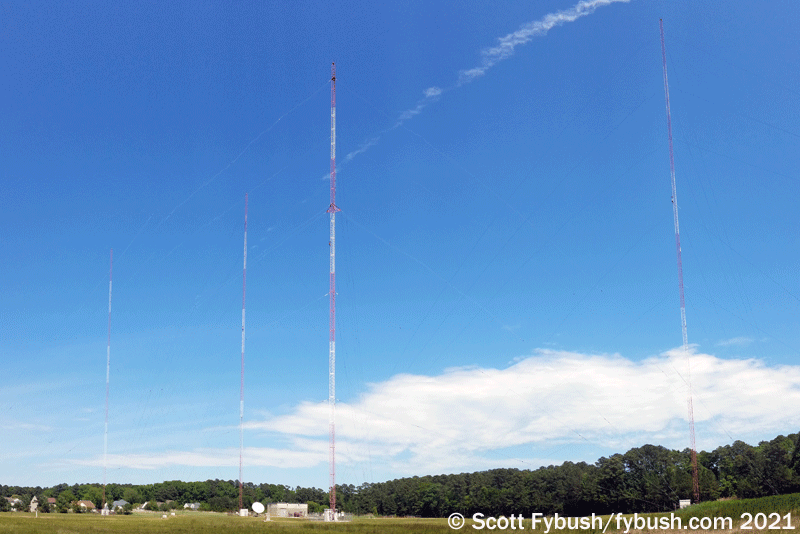
As we explained last week, the 790 signal was known for most of its long existence here as WTAR, boasting a proud history going back to 1923. Claiming a legacy as the first radio station in Virginia (partly true – an earlier Norfolk station, WSN, came and went in 1922), WTAR had the heft of the Virginian-Pilot newspaper ownership behind it, allowing it to be first in town with TV (WTAR-TV 4, now WTKR 3) and FM, among other things. For many years, WTAR’s studios were in a showplace next to the newspaper in downtown Norfolk, a building still in use by WTKR – but when the radio and TV stations went into separate hands in the early 1980s, radio moved out, and it’s now in a tall office tower in downtown Norfolk.
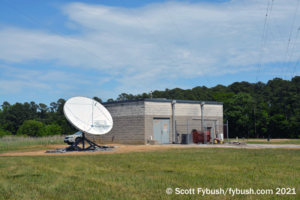

It was around that same time that WTAR’s transmitter site also moved. Since the middle of the 1930s, when it was still on its pre-NARBA frequency of 780, WTAR’s transmitter had been east of Norfolk, in what was then sparsely-populated farmland on the way out to Virginia Beach. As Virginia Beach boomed in the 1960s and 1970s, WTAR’s site at Military Highway and Curlew Drive ended up right next to busy I-264 in the midst of massive suburban development.
Today, there’s an office park housing a big collection agency in the spot where WTAR used to be – and the 790 signal now beams into Norfolk from the northeast from this site, which went on the air around 1984 with 5000 watts, using the same pattern day and night from all four towers.
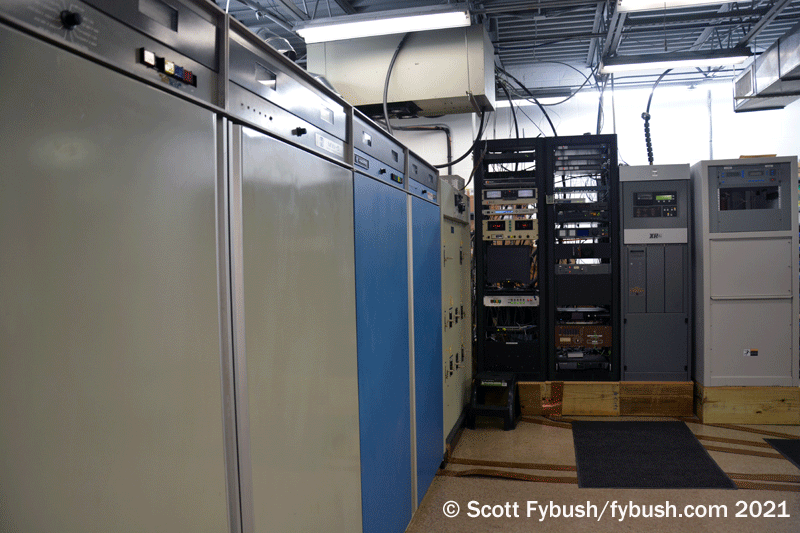
The WNIS calls arrived here in 1997, once Sinclair Telecable had bought 790 and swapped calls and formats – its news-intensive WNIS moved here from 850, while WTAR and the talk format it then used went up the dial to 850 from that frequency’s new facility up the James River.
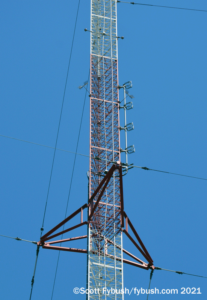
The pair of MW5 transmitters that went in back in the 1980s are still here and are still the primary transmitters for 790. At this coastal site, lightning is a big issue, and all the ferrites and grounding in the world still haven’t made that newer Nautel transmitter happy, so the Harrises soldier on. (In fact, one reason we were here was because we were bearing a box full of MW5 parts cannibalized from a decommissioned MW5 up here in Rochester!)
What’s that FM transmitter off to the side? It’s part of a move-in story that started 40 miles across the Chesapeake on Virginia’s remote Eastern Shore. The 106.1 frequency was dropped in as a class A signal in Exmore, halfway up the Eastern Shore, in the mid-90s, though it didn’t sign on until 2001 as WEXM.
After being sold to Sinclair Telecable, 106.1 started migrating closer to the heart of the Hampton Roads. By 2004, it had been relicensed to Poquoson, on the peninsula just north of this site, and was on the air as a class A signal from a four-bay antenna mounted on one of the AM towers. That, too, was just one hop in a bigger upgrade – and in next week’s installment, we’ll show you where it ended up next, and how it all ties right back in to the AM history we started chronicling for you last week.
Thanks to Dave Morgan for the tour!
SPRING IS HERE…
And if you don’t have your Tower Site Calendar, now’s the time!
If you’ve been waiting for the price to come down, it’s now 30 percent off!
This year’s cover is a beauty — the 100,000-watt transmitter of the Voice Of America in Marathon, right in the heart of the Florida Keys. Both the towers and the landscape are gorgeous.
And did you see? Tower Site of the Week is back, featuring this VOA site as it faces an uncertain future.
Other months feature some of our favorite images from years past, including some Canadian stations and several stations celebrating their centennials (buy the calendar to find out which ones!).
We still have a few of our own calendars left – as well as a handful of Radio Historian Calendars – and we are still shipping regularly.
The proceeds from the calendar help sustain the reporting that we do on the broadcast industry here at Fybush Media, so your purchases matter a lot to us here – and if that matters to you, now’s the time to show that support with an order of the Tower Site Calendar. (And we have the Broadcast Historian’s Calendar for 2025, too. Why not order both?)
Visit the Fybush Media Store and place your order now for the new calendar, get a great discount on previous calendars, and check out our selection of books and videos, too!
And don’t miss a big batch of Hampton Roads IDs next Wednesday, over at our sister site, TopHour.com!
Next week: Norfolk, Portsmouth and more disappearing history

